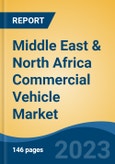Speak directly to the analyst to clarify any post sales queries you may have.
10% Free customizationThis report comes with 10% free customization, enabling you to add data that meets your specific business needs.
Market Drivers
Infrastructure Development
The ongoing investment in infrastructure development across the MENA region is a key factor driving the commercial vehicle market. Governments and private developers are allocating substantial budgets to build roads, transportation hubs, and logistics corridors, which increase the requirement for trucks, vans, and buses. These vehicles play a critical role in transporting materials and people across rapidly evolving urban and industrial zones. Enhanced infrastructure improves connectivity and reduces transportation bottlenecks, encouraging businesses to expand their fleets. As trade and industrial activities scale up, demand for commercial vehicles continues to rise in line with the need for efficient, scalable, and sector-specific mobility solutions.Key Market Challenges
Fluctuating Fuel Prices
The volatility of fuel prices poses a considerable challenge for commercial vehicle fleet operators across the MENA region. Fuel expenses account for a large portion of operating costs, and price fluctuations can negatively impact budgeting, profitability, and pricing strategies. Sudden spikes in fuel prices can lead to increased costs for logistics and transport companies, which may struggle to pass on these increases to customers. For operators managing large fleets, such unpredictability complicates financial planning and discourages long-term investment in vehicle acquisition or upgrades. While alternative fuel solutions are gaining interest, their adoption remains limited due to the high initial investment and infrastructure requirements.Key Market Trends
Electrification of Commercial Fleets
The trend toward fleet electrification is gaining momentum in the MENA commercial vehicle market as stakeholders focus on sustainability and emissions reduction. Electric commercial vehicles are becoming increasingly attractive due to their lower operating costs and environmental benefits. Governments are introducing incentives and policies to promote clean mobility, while advancements in battery technology have improved vehicle range and cost-efficiency. The growing availability of charging infrastructure is further supporting this transition, especially in urban areas where EVs are well-suited for short to mid-range operations. Fleet owners are gradually adopting electric models to meet regulatory requirements, reduce dependency on fossil fuels, and align with ESG goals.Key Market Players
- TATA Motors Ltd
- MAN Truck & Bus Middle East FZE
- Ashok Leyland (U.A.E) L.L.C
- Mercedes-Benz Group AG
- Scania AB
- Toyota Motor Corporation
- Ab Volvo
- Isuzu Motors International FZE
- Zhengzhou Yutong Bus Co., Ltd.
- General Motors Corporation
Report Scope:
In this report, the Middle East & North Africa Commercial Vehicle Market has been segmented into the following categories, in addition to the industry trends which have also been detailed below:Middle East & North Africa Commercial Vehicle Market, By Vehicle Type:
- Light Commercial Vehicle (LCV)
- Medium Commercial Vehicle (MCV)
- Heavy Commercial Vehicle (HCV)
Middle East & North Africa Commercial Vehicle Market, By Propulsion Type:
- ICE
- Electric
Middle East & North Africa Commercial Vehicle Market, By Application:
- Construction
- Logistics
- Mining
- Oil & Gas
- Others
Middle East & North Africa Commercial Vehicle Market, By Country:
- Turkey
- Saudi Arabia
- Egypt
- UAE
- Israel
- Morocco
- Kuwait
Competitive Landscape
Company Profiles: Detailed analysis of the major companies present in the Middle East & North Africa Commercial Vehicle Market.Available Customizations
With the given market data, the publisher offers customizations according to the company’s specific needs. The following customization options are available for the report.Company Information
- Detailed analysis and profiling of additional market players (up to five).
This product will be delivered within 1-3 business days.
Table of Contents
Companies Mentioned
- TATA Motors Ltd
- MAN Truck & Bus Middle East FZE
- Ashok Leyland (U.A.E) L.L.C
- Mercedes-Benz Group AG
- Scania AB
- Toyota Motor Corporation
- Ab Volvo
- Isuzu Motors International FZE
- Zhengzhou Yutong Bus Co., Ltd.
- General Motors Corporation
Table Information
| Report Attribute | Details |
|---|---|
| No. of Pages | 135 |
| Published | July 2025 |
| Forecast Period | 2024 - 2030 |
| Estimated Market Value ( USD | $ 29.34 Billion |
| Forecasted Market Value ( USD | $ 48.32 Billion |
| Compound Annual Growth Rate | 8.6% |
| Regions Covered | Africa, Middle East |
| No. of Companies Mentioned | 10 |









